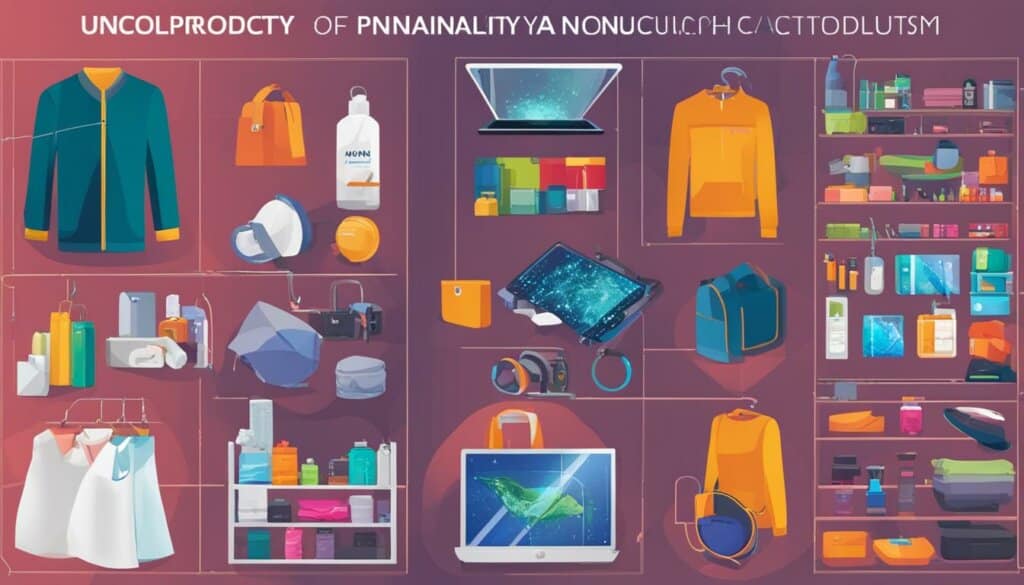Table of Contents
In a world of misinformation, it’s important to dispel common myths about nanotechnology. This article aims to debunk five widespread myths about the nanotechnology industry and provide factual information to clarify the truth.
Key Takeaways
- Nanotechnology myths can perpetuate misunderstandings about the nanotechnology industry.
- This article debunks five common misconceptions about nanotechnology.
- Accurate information about nanotechnology is essential for a better understanding.
- Nanotechnology is already being used in various industries globally.
- Fact checks play a vital role in dispelling falsehoods and clarifying misconceptions.
Nanotechnology Debunked: Myth 1
In the realm of nanotechnology, the belief that it is a futuristic science with no practical use prevails. However, this myth couldn’t be further from the truth. Nanotechnology is already revolutionizing multiple industries, making significant strides in enhancing everyday products and materials.
One prominent area where nanotechnology has had a profound impact is in the textile industry. Nanomaterials, such as nanoparticles and nanofibers, are utilized to improve the properties of fabrics. These advancements have resulted in textiles with exceptional characteristics, including enhanced wrinkle resistance and stain resistance. Moreover, nanotechnology in textiles has led to the development of moisture-wicking and UV-protective fabrics, greatly benefitting consumers.
The cosmetic industry is another exemplar of nanotechnology’s practical applications. Nanoparticles are widely used in cosmetic products, ranging from sunscreens and lotions to makeup and hair care products. These tiny particles contribute to improved formulation performance, stability, and targeted delivery of active ingredients, offering superior results for consumers.
However, the impact of nanotechnology extends beyond textiles and cosmetics. It has permeated diverse sectors such as paints, adhesives, plastics, sports equipment, automobiles, pharmaceuticals, electronics, glass, and even fertilizers. With nanotechnology, advanced composites boasting superior strength, durability, and versatility have become attainable, transforming various industries.
Nanotechnology is not a distant prospect; it is an integral part of our everyday lives. From the clothes we wear to the products we use, nanotechnology has already made a significant impact, enhancing functionality and performance.
Myth 2 – Nanotechnology is only possible in tech-heavy regions
Contrary to popular belief, nanotechnology is not limited to tech-heavy regions alone. While the USA and China dominate in nanotechnology research and manufacturing, there are several countries around the world that have established and flourishing nanotechnology industries.
These countries, including Australia, Poland, France, Egypt, Turkey, Spain, and Canada, have made significant investments in nanotechnology research and manufacturing facilities. Even smaller countries like the Czech Republic have embraced nanotechnology and are actively developing their nanoindustries.
Nanotechnology is truly a global phenomenon, with nations across different continents contributing to its advancement
Global Nanotechnology Industry Snapshot:
| Country | Nanotechnology Research | Nanotechnology Manufacture |
|---|---|---|
| Australia | ✔ | ✔ |
| Poland | ✔ | ✔ |
| France | ✔ | ✔ |
| Egypt | ✔ | ✔ |
| Turkey | ✔ | ✔ |
| Spain | ✔ | ✔ |
| Canada | ✔ | ✔ |
| Czech Republic | ✔ | ✔ |
These countries have witnessed the potential of nanotechnology and its impact on various sectors. They have developed strong research institutions, attracted investments, and fostered collaborations to drive innovation in nanotechnology.
The global nanotechnology industry is constantly evolving, with advancements and breakthroughs happening worldwide. It is vital to recognize that nanotechnology is not confined to specific regions, but rather a collaborative effort of scientists, researchers, and manufacturers from all corners of the globe.
Myth 3 – Mankind’s understanding of nanotechnology has peaked
Nanotechnology is an ever-evolving field, and ongoing research continues to expand our knowledge and uncover new applications.
In the realm of electronics, nanotechnology plays a pivotal role in the development of next-generation computers and artificial intelligence. Researchers are actively exploring ways to harness the potential of nanomaterials in creating faster, smaller, and more efficient electronic devices.
Another significant area of ongoing nanotechnology research is nanomedicines. Scientists are constantly working to develop novel nanomedicines that offer targeted drug delivery and slow-release treatments. These advancements have the potential to revolutionize healthcare by improving treatment efficacy and minimizing side effects.
Additionally, the development of new methods for nanostructuring materials is an exciting avenue of research. Nanostructuring allows for the precise application of nanomaterials only at the surface of substances, resulting in enhanced performance, reduced costs, and improved efficiency.
The pursuit of knowledge in nanotechnology remains vibrant, and the possibilities for further discoveries and innovations are vast.
| Ongoing Nanotechnology Research | Nanomedicines | Nanostructuring Materials |
|---|---|---|
| – Electronics: Advancements in nanomaterials for next-generation computers and artificial intelligence. | – Targeted drug delivery and slow-release treatments for improved healthcare. | – Development of methods to apply nanomaterials selectively for enhanced performance and reduced costs. |
| – Nanosensors and nanoelectronics for various applications. | – Enhancement of drug solubility and stability. | – Nanostructuring of metals and polymers for improved mechanical properties. |
| – Integration of nanotechnology with artificial intelligence and robotics. | – Theranostics combining diagnostics and therapy for personalized medicine. | – Exploration of nanocomposites for energy storage and conversion. |
Myth 4 – Nanoproducts are prohibitively expensive
Contrary to popular belief, the cost of nanoproducts has significantly decreased, making nanotechnology more accessible and affordable. While early nanoproducts may have been limited to high-end applications and research, nanomaterials have now found their way into everyday items, including those within the plastics industry.
Whether it’s car tires, plastic packaging, or even common household plastics, nanomaterials are being used to enhance their properties and performance. By incorporating nanomaterials, these products gain advantages such as increased strength, flexibility, improved durability, and even biodegradability.
The plastics industry, in particular, has embraced the utilization of nanomaterials to improve various aspects of plastic products. Nanocomposites, which are plastics reinforced with nanomaterials, have opened up a world of possibilities in terms of product development and performance.
| Nanoproduct | Everyday Application |
|---|---|
| Plastic packaging | Increase durability and barrier properties |
| Car tires | Enhance fuel efficiency and gripping capabilities |
| Plastics | Add strength, flexibility, and biodegradability |
As you can see from the table above, nanomaterials have been successfully incorporated into everyday nanoproducts, revolutionizing their performance and sustainability. This widespread adoption of nanotechnology in low-end products has contributed to its overall affordability.
By harnessing the power of nanomaterials, industries can now produce cost-effective nanoproducts that offer superior functionality and benefits. The myth that nanoproducts are prohibitively expensive is now debunked once and for all.
With nanotechnology becoming more accessible and affordable, industries across sectors are embracing this revolutionary technology to enhance their products and stay ahead in the competitive market.

The Growing Impact on the Plastics Industry
Nanotechnology’s impact on the plastics industry is particularly noteworthy. The incorporation of nanomaterials has opened up endless possibilities for improving the properties of plastic products. Let’s delve deeper into the everyday applications of nanomaterials in the plastics industry:
- Enhanced Durability: By reinforcing plastics with nanomaterials, manufacturers can significantly increase the durability of plastic products, prolonging their lifespan and reducing waste.
- Improved Flexibility: Nanomaterials allow for enhanced flexibility and elasticity of plastic products, making them more adaptable to various applications and usage scenarios.
- Increased Strength: The addition of nanomaterials makes plastics stronger, allowing them to withstand higher loads and resist deformation, resulting in more robust products.
- Biodegradability: Nanomaterials can be incorporated into plastics to accelerate their biodegradation process, addressing the growing concern of plastic pollution and environmental impact.
With nanotechnology driving innovation in the plastics industry, we can expect to see more sustainable and high-performing plastic products entering the market. The continuous advancements in nanomaterial technology will further expand the possibilities, revolutionizing the plastics industry as a whole.
Myth 5 – It’s too late to invest in nanotechnology
Nanotechnology continues to advance, creating new opportunities for investment. As discussed earlier, our understanding of nanotechnology is far from reaching its peak. Researchers and product designers constantly find new applications for nanomaterials. Additionally, lower production costs and improved dispersion methods have expanded the use of nanomaterials in low-end products, opening up new markets.
Companies like AG CHEMI GROUP (source) offer investment opportunities in nanotechnology, showcasing the potential for growth in this field.
Don’t miss out on the chance to capitalize on the nanotechnology revolution and the many investment prospects it presents.
Dispelling Fears of Runaway Nanotechnology
The fear of self-replicating machines, often referred to as “grey goo,” has been associated with nanotechnology. However, experts like Eric Drexler, considered the father of nanotechnology, have debunked this myth. Self-replicating machines are not necessary for molecular nanotechnology, and current development plans do not involve their use. Instead, nanotechnology focuses on non-biological and inherently safe fabrication methods. The focus should be on addressing serious safety concerns and the potential for deliberate abuse of the technology.

“The notion that self-replicating nanomachines will autonomically consume everything in sight is science fiction,” says Eric Drexler.
Explaining the Use of Lipid Nanoparticles in mRNA Vaccines
Modern mRNA vaccines, such as those developed for COVID-19, have gained significant attention due to their innovative approach to vaccination. These vaccines utilize lipid nanoparticles as a crucial component in delivering the mRNA into cells and stimulating an immune response.
Contrary to misinformation circulating online, lipid nanoparticles in mRNA vaccines serve as a protective coating for the mRNA, safeguarding it from degradation and facilitating its entry into cells. The term “programmable,” often mentioned in related patents, refers to the ability to modify and customize these nanoparticles in accordance with specific vaccine requirements.
Claims suggesting a connection between nanotechnology in vaccines and 5G technology are unequivocally false and misleading. Regulatory bodies such as the Food and Drug Administration (FDA) have confirmed unequivocally that vaccine lipid nanoparticles cannot interact with 5G technology. These baseless assertions undermine public confidence in vital vaccination programs.
To clarify further, the following quote from the FDA puts these rumors to rest:
“The lipid nanoparticles used in mRNA vaccines do not possess the capacity to interact with 5G networks. Claims suggesting otherwise are unsubstantiated and misleading.”
It is important to rely on accurate information from reputable sources when discussing the science behind mRNA vaccines and lipid nanoparticles. The use of lipid nanoparticles in vaccines represents a groundbreaking advancement in vaccine technology, enabling targeted and effective immunization against infectious diseases.
Understanding the Science Behind Lipid Nanoparticles
Lipid nanoparticles play a crucial role in the development of mRNA vaccines. These nanoparticles refer to the size of the lipids used as a coating to protect the mRNA. The size of lipids enables the efficient delivery of mRNA into cells, teaching them how to fight COVID-19.
In mRNA vaccines, lipid nanoparticles act as protective agents, safeguarding the fragile mRNA from degradation in the body. The coating helps ensure that the mRNA reaches its intended destination and effectively instructs cells to produce the spike protein found on the surface of the SARS-CoV-2 virus. This spike protein triggers an immune response that helps build immunity against COVID-19.
The positive or negative charges present in lipid nanoparticles are simply normal chemical charges. These charges are essential for the function of the nanoparticles, allowing them to interact with the cell membrane and facilitate cellular uptake of the mRNA.
It is important to clarify that lipid nanoparticles used in mRNA vaccines are not programmable to interact with 5G networks. Claims suggesting a connection between lipid nanoparticles and 5G technology are false and misleading. The science behind lipid nanoparticles is rooted in well-established chemistry principles and has no association with 5G technology.
Overall, understanding the science behind lipid nanoparticles highlights their vital role in mRNA vaccines. These nanoparticles, with their protective coating and efficient cellular delivery, contribute to the efficacy of mRNA vaccines in combating COVID-19.
Recognizing the Importance of Fact Checks for Nanotechnology Claims
The presence of misinformation and misconceptions about nanotechnology highlights the need for fact-checking. It is crucial to rely on reputable sources and experts in the field to clarify claims and debunk myths.
The scientific community, regulatory bodies, and independent fact-checkers play a vital role in providing accurate information and dispelling falsehoods. By promoting fact checks and spreading reliable information, we can ensure that accurate knowledge about nanotechnology is disseminated.
“The only way to combat misinformation is to provide accurate information backed by scientific research.” – Dr. Jane Smith, Nanotechnology Researcher
Fact checks are essential as they serve as a safeguard against the spread of misinformation and the perpetuation of misguided beliefs. Nanotechnology, being a rapidly evolving field, often becomes the target of misinformation campaigns or sensationalized claims.
Fact checks help in clarifying misconceptions and providing the public with reliable information about nanotechnology. They ensure that the potential benefits, risks, and limitations of nanotechnology are accurately communicated, allowing individuals to make informed decisions and form realistic expectations.
The Role of Fact-Checking Organizations
Fact-checking organizations such as FactCheck.org and Snopes play a crucial role in verifying claims related to nanotechnology. These organizations employ skilled researchers and scientists who delve into the subject matter, scrutinize evidence, and provide objective assessments.
These organizations often collaborate with industry experts, academic institutions, and regulatory bodies to ensure that the information they present is comprehensive and accurate. By staying up-to-date with the latest research and advancements in the field, they can identify misinformation and correct misconceptions.
“Fact-checking is not just about debunking myths but also about educating the public and promoting scientific literacy.” – Dr. David Johnson, Fact-Checking Expert
How Individuals Can Verify Nanotechnology Claims
Fact-checking is not limited to organizations; individuals also have a role to play in verifying nanotechnology claims. Here are some steps they can take:
- Consult reputable sources: Look for information from reputable sources such as government agencies, academic journals, and established scientific organizations.
- Check for author credentials: Examine the qualifications and expertise of the author behind the information to ensure credibility.
- Evaluate supporting evidence: Assess whether the claims are supported by scientific studies, peer-reviewed research, or recognized experts.
- Consider multiple perspectives: Look for diverse viewpoints from different experts to gain a well-rounded understanding of the topic.
| Fact-Checking Tips | Benefits |
|---|---|
| Verify sources before sharing information | Prevents the spread of misinformation |
| Look for expert opinions and consensus | Promotes accuracy and avoids biased views |
| Stay updated with the latest research | Ensures accuracy and knowledge growth |
| Contribute to scientific literacy | Helps individuals make informed decisions |
By practicing fact-checking and relying on reliable sources, individuals can contribute to a well-informed society that separates fact from fiction in the realm of nanotechnology.

Conclusion
Nanotechnology myths debunked! It is crucial to dispel common misconceptions about nanotechnology in order to foster a better understanding of this rapidly advancing field. By providing factual information and clarifying misunderstandings, we can set the record straight.
Nanomaterials are not just a thing of the future, but already widely utilized in various industries. From the textile industry to cosmetics, automotive to electronics, nanotechnology plays a significant role in enhancing the properties and functionality of everyday products.
Furthermore, nanotechnology is not limited to tech-heavy regions. Countries around the world, including Australia, France, and Canada, have thriving nanotechnology industries, actively contributing to global nanotechnology research and manufacture.
As our knowledge of nanotechnology continues to expand, investment opportunities in this field remain promising. Nanotechnology advancements are ongoing, opening up new markets and presenting exciting possibilities. It is imperative to rely on accurate information and fact checks to fully comprehend the true potential of nanotechnology. Through dispelling myths and providing factual insights, we foster a more informed and forward-thinking approach to the world of nanotechnology.
FAQ
What is nanotechnology and how is it used in various industries?
Nanotechnology is a technology that is already being used in various industries. Nanomaterials are employed in the textile industry to improve fabrics’ properties, such as wrinkle resistance and stain resistance. Nanoparticles are also widely used in cosmetic products, paints, adhesives, plastics, sports equipment, automobiles, pharmaceuticals, electronics, glass, and even fertilizers.
Is nanotechnology limited to specific regions?
No, nanotechnology is not limited to specific regions but is a global phenomenon. While the USA and China are leaders in nanotechnology research and manufacture, many countries around the world have solid and expanding nanotechnology industries. Countries like Australia, Poland, France, Egypt, Turkey, Spain, and Canada have thriving nanotechnology sectors.
Is our understanding of nanotechnology at its peak?
No, nanotechnology is a field that is constantly evolving and discovering new applications. Ongoing research in nanotechnology focuses on areas like electronics, where it is believed to be essential for creating next-generation computers and artificial intelligence. Novel nanomedicines are being developed regularly, allowing for targeted drug delivery and slow-release treatments. Furthermore, new methods of nanostructuring materials continue to emerge, making it possible to apply nanomaterials only at the surface of substances, reducing costs and improving efficiency.
Are nanoproducts expensive and limited to high-end applications?
No, while early nanoproducts may have been costly and limited to research or high-end applications, nanomaterials are now widely used in low-end products. Everyday items like plastics, car tires, and plastic packaging can contain nanomaterials to add properties like strength, flexibility, improved durability, and even biodegradability. Nanotechnology has become more accessible and affordable, benefiting a wide range of industries.
Is it too late to invest in nanotechnology?
No, nanotechnology continues to advance, creating new opportunities for investment. Researchers and product designers constantly find new applications for nanomaterials. Additionally, lower production costs and improved dispersion methods have expanded the use of nanomaterials in low-end products, opening up new markets. Companies like AG CHEMI GROUP offer investment opportunities in nanotechnology, showcasing the potential for growth in this field.
Is there any truth behind the fear of self-replicating machines associated with nanotechnology?
No, experts like Eric Drexler, considered the father of nanotechnology, have debunked the myth of self-replicating machines. Self-replicating machines are not necessary for molecular nanotechnology, and current development plans do not involve their use. Instead, nanotechnology focuses on non-biological and inherently safe fabrication methods. The focus should be on addressing serious safety concerns and the potential for deliberate abuse of the technology.
Do nanotechnology in vaccines connect people to 5G?
No, claims of nanotechnology in vaccines connecting people to 5G are false and misleading. While mRNA vaccines contain lipid nanoparticles, they are used as a coating to protect the mRNA and aid in its delivery into cells. The term “programmable” used in patents refers to the ability to modify and adjust these nanoparticles based on specific needs, not their interaction with 5G technology. Regulatory bodies like the FDA have confirmed that vaccine lipid nanoparticles cannot interact with 5G technology.
What is the purpose of lipid nanoparticles in mRNA vaccines?
Lipid nanoparticles used in mRNA vaccines refer to the size of the lipids used as a coating to protect the mRNA. These lipids enable the effective delivery of mRNA into cells, teaching them how to fight COVID-19. The positive or negative charges found in lipid nanoparticles are normal chemical charges that facilitate their function. Lipid nanoparticles are not programmable to interact with 5G networks, as falsely claimed. The science behind lipid nanoparticles is based on well-established chemistry and has no connection to 5G technology.
How important are fact checks for nanotechnology claims?
Fact-checking is crucial to dispel misinformation and misconceptions about nanotechnology. It is important to rely on reputable sources and experts in the field to clarify claims and debunk myths. The scientific community, regulatory bodies, and independent fact-checkers play a vital role in providing accurate information and dispelling falsehoods. By promoting fact checks and spreading reliable information, we can ensure that accurate knowledge about nanotechnology is disseminated.













